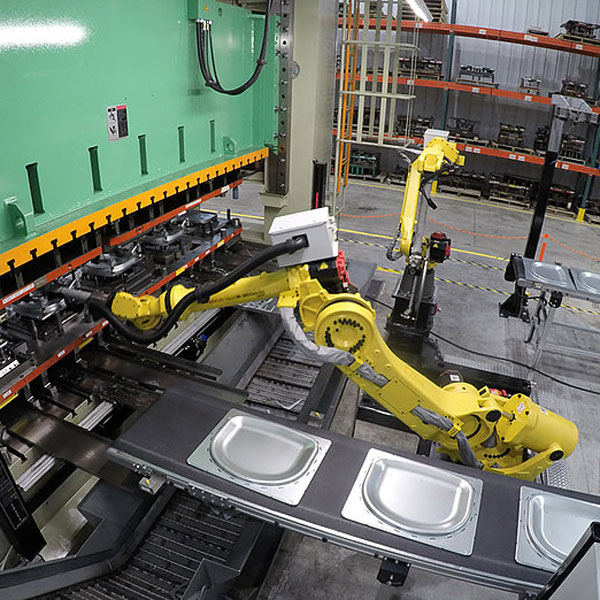Metal Stamping: Innovations Driving Market Development
Metal Stamping: Innovations Driving Market Development
Blog Article
Steel Marking Developments: Elevating Manufacturing Processes for Superior Outcomes
In the realm of manufacturing processes, metal stamping has long been a foundation method for generating a range of precision parts. With the unrelenting march of technical development, the landscape of metal marking is undertaking a significant change. Developments in this field are not just boosting the effectiveness and high quality of production yet are also leading the means for new opportunities that were previously beyond reach. As the sector welcomes these advanced growths, a redefinition of what is attainable in production is underway, promising remarkable results and setting brand-new standards for excellence in the field.
Advancement of Metal Stamping Methods

Additionally, innovations in material science have actually caused the advancement of high-strength alloys that can currently be seamlessly marked into detailed shapes, dealing with a more comprehensive series of industrial applications. The assimilation of robotics and man-made knowledge has further maximized the marking process by boosting rate and precision while decreasing the danger of human error.

Influence of Advanced Products
Have advanced materials changed steel stamping processes considerably in the production sector? By using materials such as high-strength alloys, advanced compounds, and cutting-edge coatings, metal marking procedures can now generate elements that are lighter, more powerful, and extra resilient than ever previously.
These sophisticated products provide remarkable mechanical buildings, corrosion resistance, and thermal security, permitting manufacturers to fulfill the needs of modern industries such as aerospace, automotive, and electronics. Additionally, making use of advanced materials in metal stamping has promoted the manufacturing of complicated geometries and detailed designs that were formerly unattainable with conventional techniques.
Furthermore, the implementation of sophisticated products has caused minimized product waste, lower manufacturing prices, and shorter lead times, making metal stamping processes much more affordable and sustainable. As innovation remains to development, the influence of sophisticated materials on steel marking processes is anticipated to drive additional advancement and improve the competitiveness of manufacturers in the global market.
Automation in Steel Stamping
The development of steel stamping procedures driven by the assimilation of sophisticated materials has actually established the stage for significant innovations in automation within the manufacturing industry. Automation in steel stamping has actually changed production processes, improving performance, accuracy, and general outcome high quality. Via the utilization of robotics, sensors, and computer-controlled systems, tasks that were time-consuming and once hand-operated can currently be implemented with unmatched speed and precision.
Automation in steel marking not just increases production prices however also ensures consistency in the manufacturing procedure. By lessening human intervention, the threat of errors is substantially lowered, leading to higher degrees of item uniformity and reliability. Furthermore, automation allows manufacturers to undertake intricate stamping jobs that would certainly be unwise or tough to attain manually.
Furthermore, automation in steel marking adds to a more secure working atmosphere by reducing the demand for staff members to participate in harmful or repetitive jobs - Metal Stamping. This change towards automation not only enhances efficiency however additionally leads the way for the future of production, where technology plays a main role in driving functional excellence
Quality Assurance and Assessment Systems
With a concentrate on precision and integrity, quality assurance and evaluation systems play a crucial duty in guaranteeing product quality in metal stamping processes. These systems are created to keep track of every stage of production, from product assessment to the end product, to ensure that all components meet the required standards. By carrying out sophisticated innovations such as optical examination systems, coordinate measuring devices (CMM), and automated gauging tools, suppliers can identify also the smallest variances in measurements, surface area top quality, and total stability of stamped components.

Sustainability Practices in Steel Stamping
Building upon the foundation of accuracy and integrity developed through quality control and assessment systems, the integration of sustainable techniques in steel stamping procedures is progressively coming to be a focal factor for makers looking for to reduce ecological influence and enhance source usage. Sustainability techniques in steel stamping include a variety of initiatives targeted at lowering waste generation, power usage, and greenhouse gas discharges throughout the manufacturing procedure.
One key aspect of sustainability in steel stamping is the fostering of environmentally friendly products and modern technologies that promote recyclability and waste reduction. By making use of recycled products and carrying out energy-efficient machinery, manufacturers can reduce their carbon impact and add to a much more lasting production cycle. Additionally, enhancing manufacturing processes to lessen product waste and energy use not just benefits the environment yet also leads to cost savings for services over time.
Moreover, the implementation of sustainable practices in steel stamping can boost brand name reputation and attract ecologically aware consumers. As sustainability proceeds to acquire relevance in the manufacturing market, integrating environment-friendly initiatives right into metal stamping procedures is necessary for long-term success and competitiveness in the marketplace.
Verdict
Finally, metal stamping techniques have dramatically progressed gradually, including sophisticated materials and automation to improve producing processes. Quality control and evaluation systems play a crucial function in guaranteeing remarkable results, while sustainability practices are significantly Click Here being executed to minimize environmental impact. These innovations in metal marking have reinvented the industry, bring about more effective and sustainable production techniques for numerous industries.
Steel stamping, when a manual and labor-intensive process, has actually transformed into an extremely automated and innovative method of forming steel sheets into various kinds and styles.Have advanced materials changed metal stamping procedures considerably in the manufacturing market? By utilizing products such as high-strength alloys, progressed composites, and innovative finishes, steel marking procedures can now create components that are lighter, more powerful, article source and extra resilient than ever previously.
The development of metal marking processes driven by the assimilation of sophisticated products has set the stage for substantial advancements in automation within the manufacturing industry.In final thought, metal stamping strategies have dramatically advanced over time, including innovative materials and automation to enhance making procedures.
Report this page